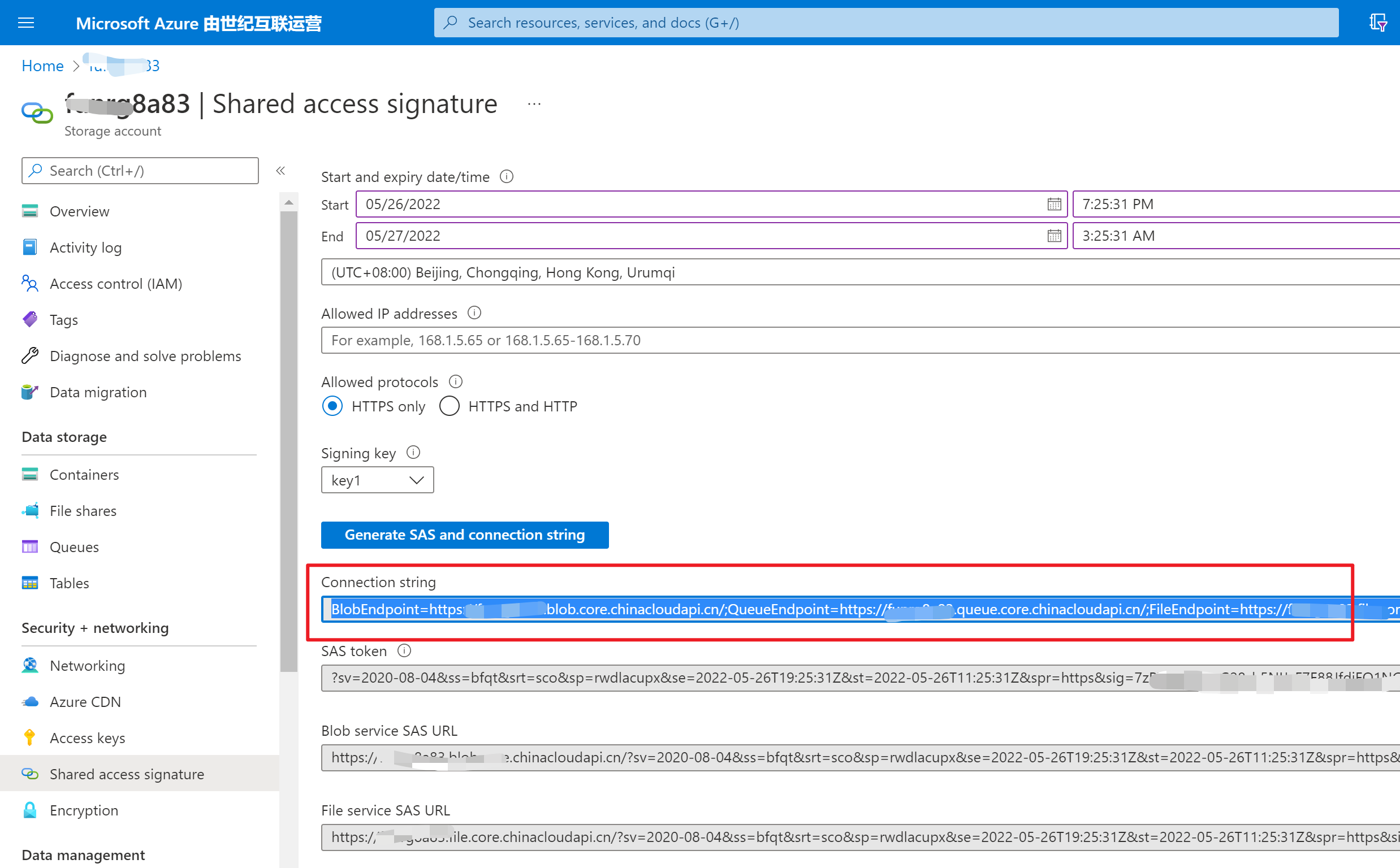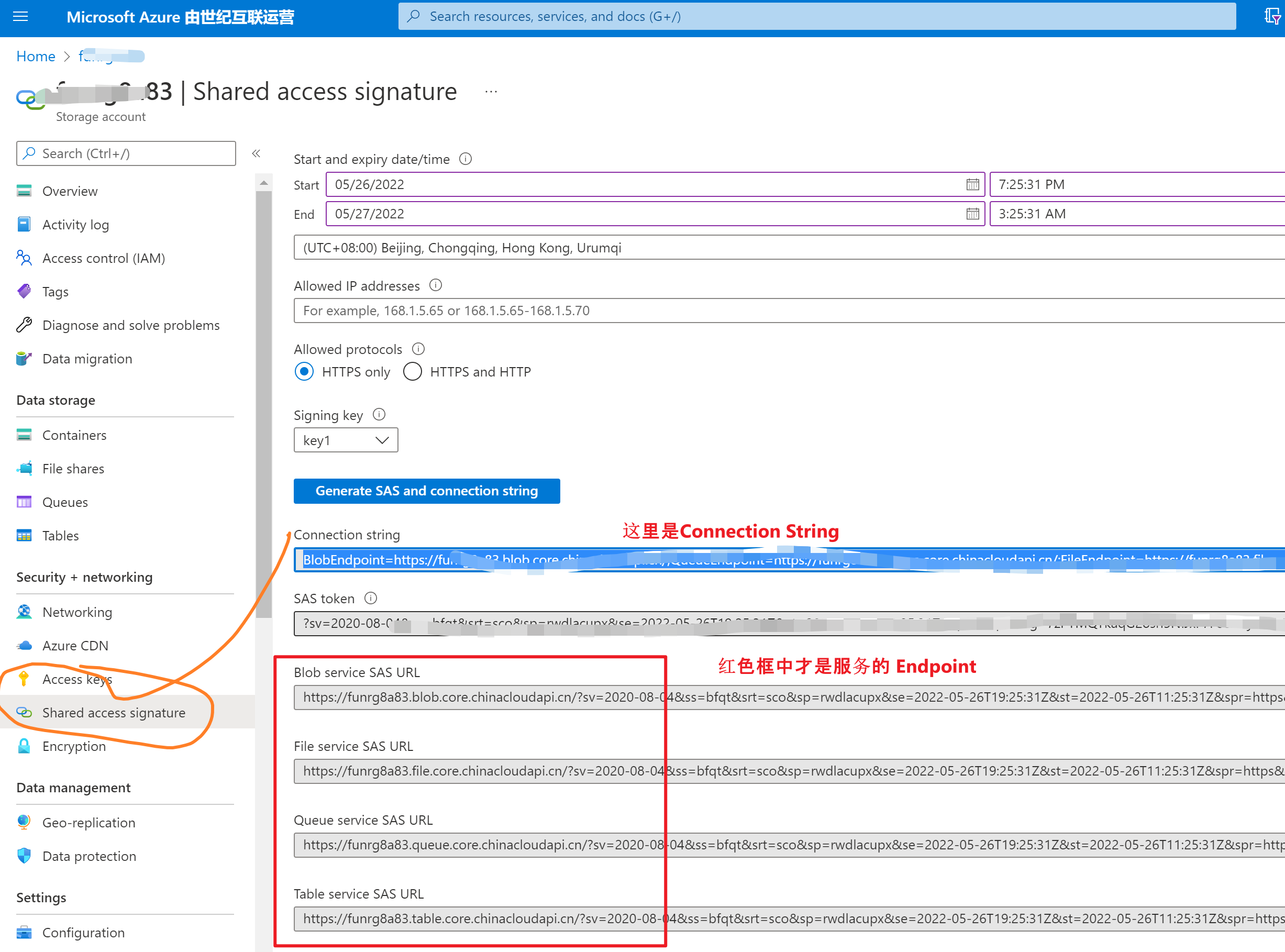问题描述
使用Azure Storage Account的共享访问签名(Share Access Signature) 生成的终结点,连接时遇见 The Azure Storage endpoint url is malformed (Azure 存储终结点 URL 格式不正确)
Storage Account SDK in pom.xml:
<dependency>
<groupId>com.azure</groupId>
<artifactId>azure-storage-blob</artifactId>
<version>12.6.0</version>
</dependency>
App.Java 文件中,创建 BlobServiceClient 对象代码:
String endpoint ="BlobEndpoint=https://://************..."; BlobServiceClient blobServiceClientbyendpoint = new BlobServiceClientBuilder().endpoint(endpoint).buildClient();
获取Endpoint的方法为(Azure Portal --> Storage Account --> Share access signature)

当执行Java 代码时,main函数抛出异常:java.lang.IllegalArgumentException: The Azure Storage endpoint url is malformed
PS C:\LBWorkSpace\MyCode\1-Storage Account - Operation Blob by Connection String - Java>
& 'C:\Program Files\Microsoft\jdk-11.0.12.7-hotspot\bin\java.exe'
'-agentlib:jdwp=transport=dt_socket,server=n,suspend=y,address=localhost:59757'
'@C:\Users\AppData\Local\Temp\cp_6ux3xmehddi1mc4fanfjupd3x.argfile'
'com.blobs.quickstart.App'
Azure Blob storage v12 - Java quickstart sample 2022-05-26 10:24:29 ERROR BlobServiceClientBuilder - The Azure Storage endpoint url is malformed. Exception in thread "main" java.lang.IllegalArgumentException: The Azure Storage endpoint url is malformed. at com.azure.storage.blob.BlobServiceClientBuilder.endpoint(BlobServiceClientBuilder.java:132) at com.blobs.quickstart.App.main(App.java:30)
问题分析
消息 [The Azure Storage endpoint url is malformed (Azure 存储终结点 URL 格式不正确)] 说明代码中使用的格式不对,回到生成endopoint的页面查看,原来使用的是连接字符串 Connection String. 与直接使用Access Key中的Connection String是相同的代码方式,而 Endpoint 是指当个连接到Blob Service的URL。

回到代码中,发现新版本把连接方式进行了区分:
- 使用Connection String时,用 new BlobServiceClientBuilder().connectionString(connectStr).buildClient();
- 使用Endpoint时,用 new BlobServiceClientBuilder().endpoint(endpoint).buildClient();
所以,解决 endpoint url malformed 关键就是使用正确的 SAS URL 或者是 Connection String
//使用连接字符串时
String connectStr ="BlobEndpoint=https://:************.blob.core.chinacloudapi.cn/;...SharedAccessSignature=sv=2020-08-0...&sig=**************"; BlobServiceClient blobServiceClient = new BlobServiceClientBuilder().connectionString(connectStr).buildClient();
//使用SAS终结点 String endpoint ="https://************.blob.core.chinacloudapi.cn/?sv=2020-08-04...&sig=*********************"; BlobServiceClient blobServiceClientbyendpoint = new BlobServiceClientBuilder().endpoint(endpoint).buildClient();
完整的示例代码:
package com.blobs.quickstart;
/**
* Azure blob storage v12 SDK quickstart
*/
import com.azure.storage.blob.*;
import com.azure.storage.blob.models.*;
import java.io.*;
public class App
{
public static void main( String[] args ) throws IOException
{
System.out.println("Azure Blob storage v12 - Java quickstart sample\n");
// Retrieve the connection string for use with the application. The storage
// connection string is stored in an environment variable on the machine
// running the application called AZURE_STORAGE_CONNECTION_STRING. If the environment variable
// is created after the application is launched in a console or with
// Visual Studio, the shell or application needs to be closed and reloaded
// to take the environment variable into account.
//String connectStr ="DefaultEndpointsProtocol=https;AccountName=******;AccountKey=***********************;EndpointSuffix=core.chinacloudapi.cn";// System.getenv("AZURE_STORAGE_CONNECTION_STRING");
String connectStr ="BlobEndpoint=https://******* */.blob.core.chinacloudapi.cn/;QueueEndpoint=https://*******.queue.core.chinacloudapi.cn/;FileEndpoint=https://*******.file.core.chinacloudapi.cn/;TableEndpoint=https://*******.table.core.chinacloudapi.cn/;SharedAccessSignature=sv=2020...&sig=*************************";
BlobServiceClient blobServiceClient = new BlobServiceClientBuilder().connectionString(connectStr).buildClient();
//Create a unique name for the container
String containerName = "lina-" + java.util.UUID.randomUUID();
// Create the container and return a container client object
BlobContainerClient containerClient = blobServiceClient.createBlobContainer(containerName);
BlobContainerClient containerClient1 = blobServiceClient.getBlobContainerClient("container-name");
if(!containerClient1.exists())
{
System.out.println("create containerName");
blobServiceClient.createBlobContainer("container-name");
}
System.out.println("create containerName .....");
// // Create a local file in the ./data/ directory for uploading and downloading
// String localPath = "./data/";
// String fileName = "quickstart" + java.util.UUID.randomUUID() + ".txt";
// File localFile = new File(localPath + fileName);
// // Write text to the file
// FileWriter writer = new FileWriter(localPath + fileName, true);
// writer.write("Hello, World!");
// writer.close();
// // Get a reference to a blob
// BlobClient blobClient = containerClient.getBlobClient(fileName);
// System.out.println("\nUploading to Blob storage as blob:\n\t" + blobClient.getBlobUrl());
// // Upload the blob
// blobClient.uploadFromFile(localPath + fileName);
// System.out.println("\nListing blobs...");
// // List the blob(s) in the container.
// for (BlobItem blobItem : containerClient.listBlobs()) {
// System.out.println("\t" + blobItem.getName());
// }
// // Download the blob to a local file
// // Append the string "DOWNLOAD" before the .txt extension so that you can see both files.
// String downloadFileName = fileName.replace(".txt", "DOWNLOAD.txt");
// File downloadedFile = new File(localPath + downloadFileName);
// System.out.println("\nDownloading blob to\n\t " + localPath + downloadFileName);
// blobClient.downloadToFile(localPath + downloadFileName);
// // Clean up
// System.out.println("\nPress the Enter key to begin clean up");
// System.console().readLine();
// System.out.println("Deleting blob container...");
// containerClient.delete();
// System.out.println("Deleting the local source and downloaded files...");
// localFile.delete();
// downloadedFile.delete();
System.out.println("Done");
}
}
参考资料
快速入门:使用 Java v12 SDK 管理 blob: https://docs.azure.cn/zh-cn/storage/blobs/storage-quickstart-blobs-java?tabs=powershell%2Cenvironment-variable-windows
版权声明:本文内容由互联网用户自发贡献,该文观点与技术仅代表作者本人。本站仅提供信息存储空间服务,不拥有所有权,不承担相关法律责任。如发现本站有涉嫌侵权/违法违规的内容, 请发送邮件至 [email protected] 举报,一经查实,本站将立刻删除。


